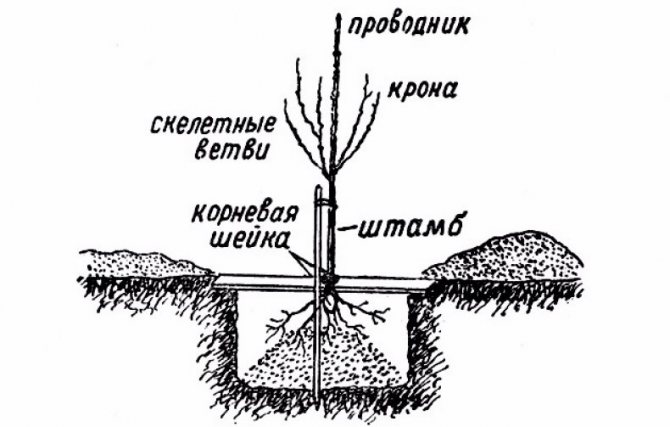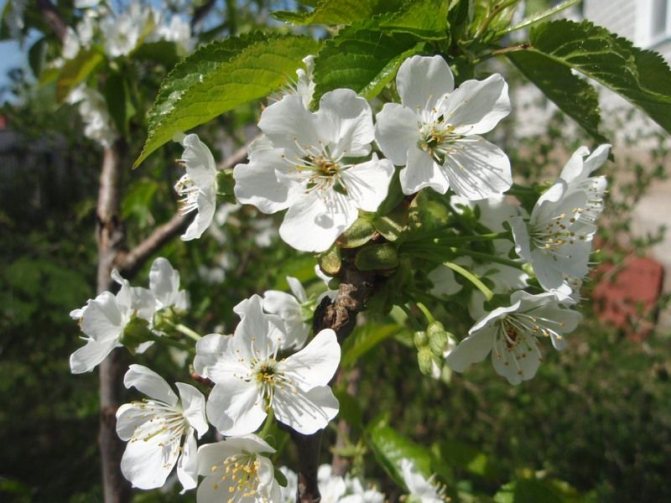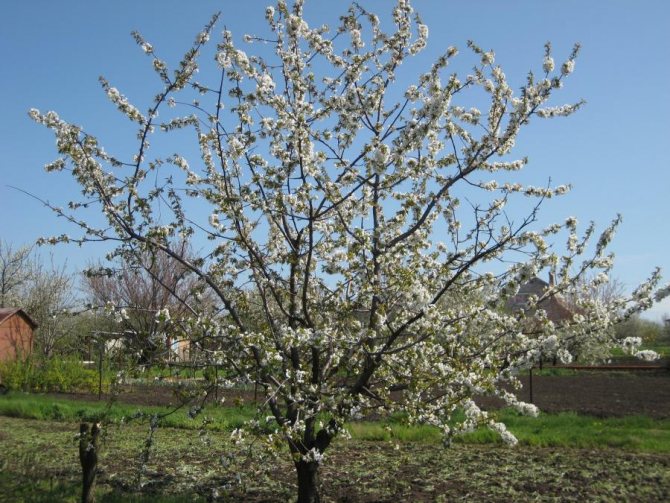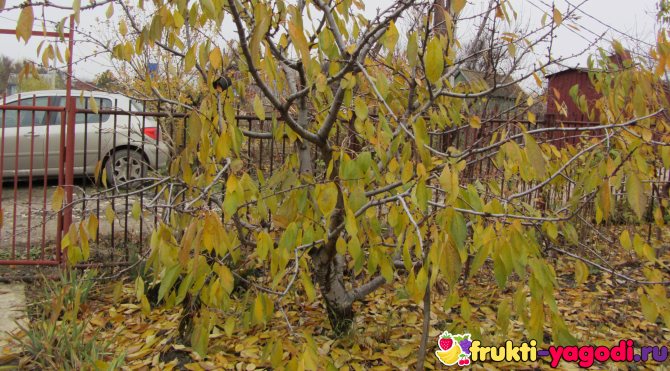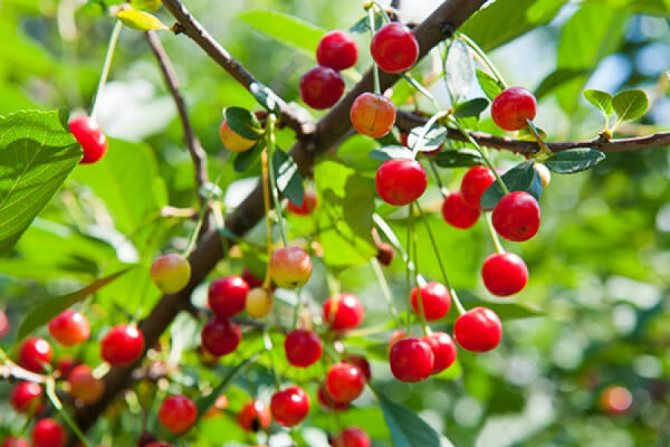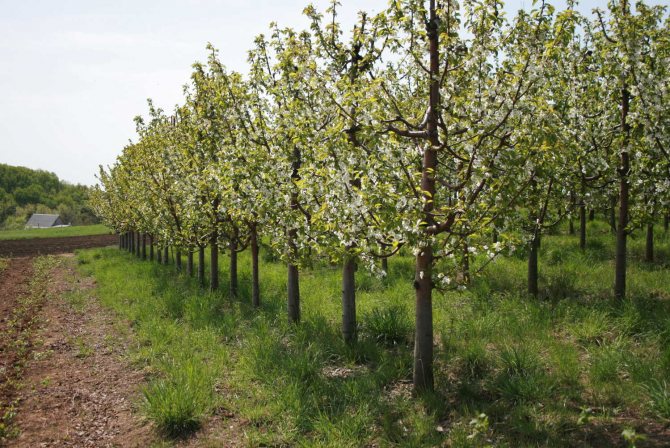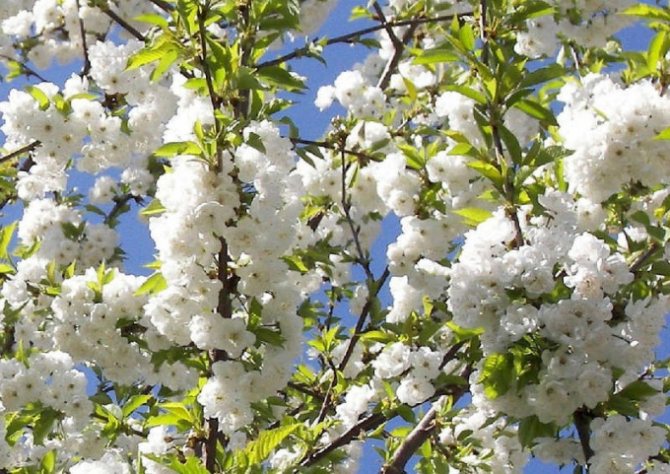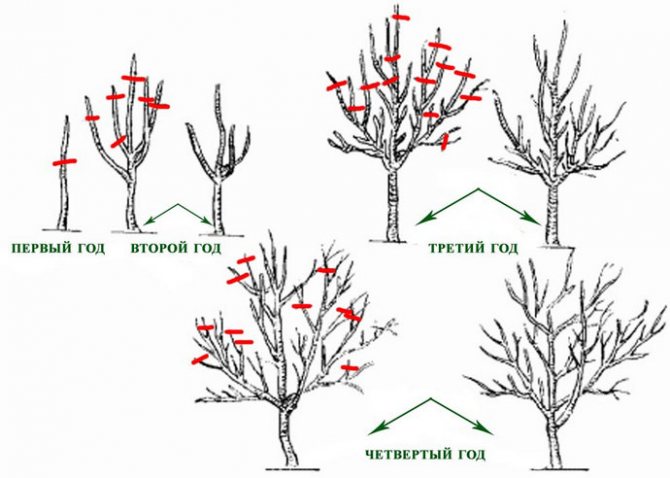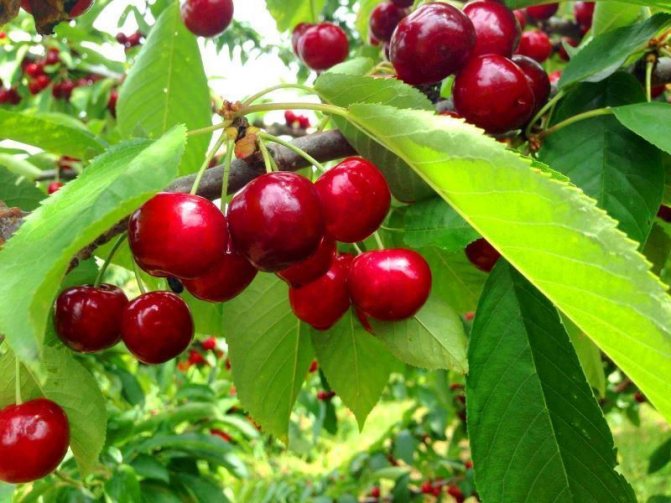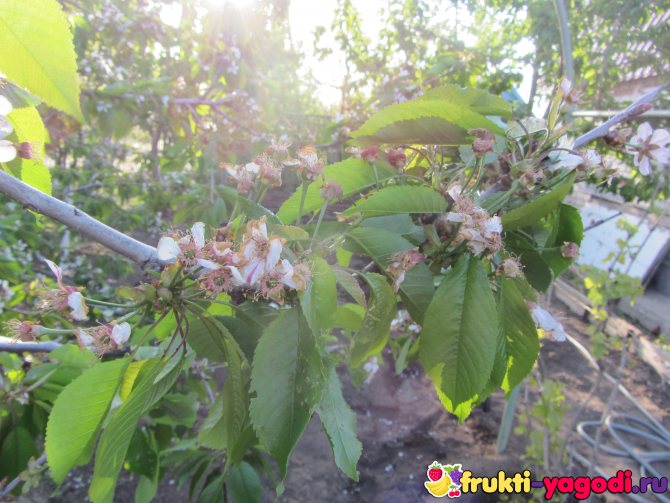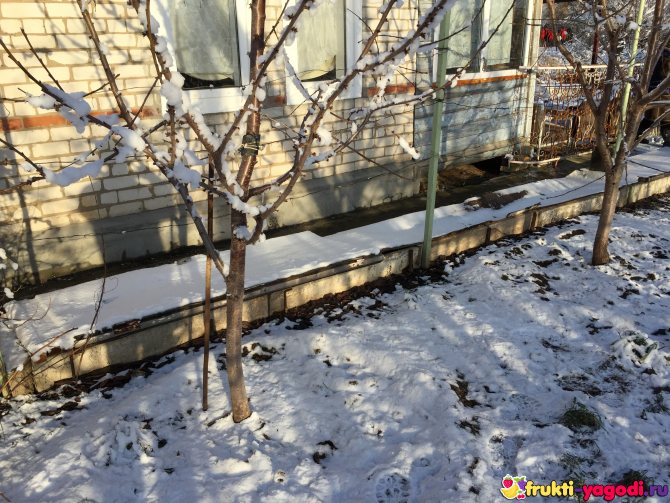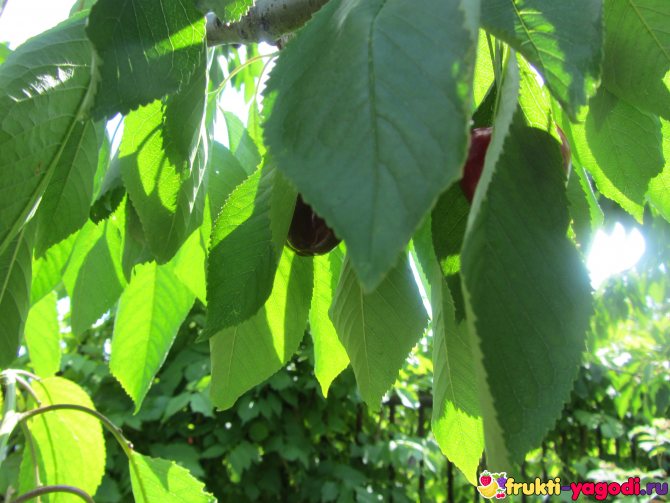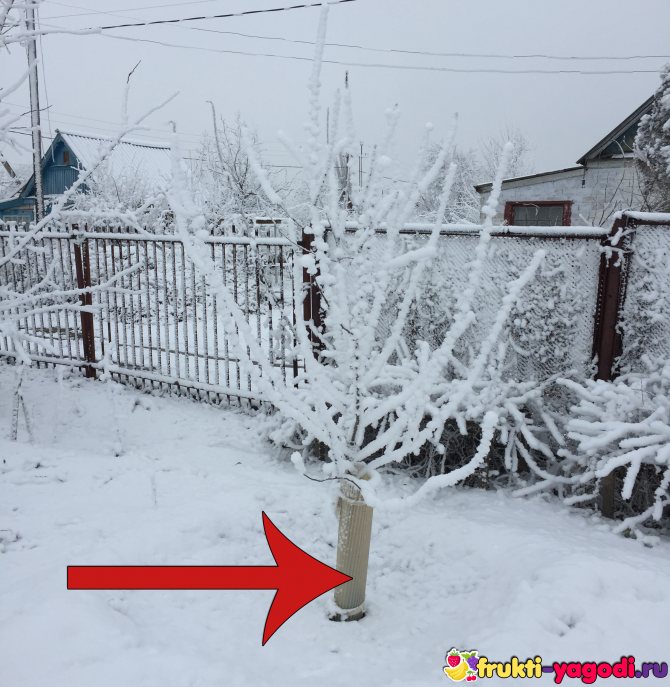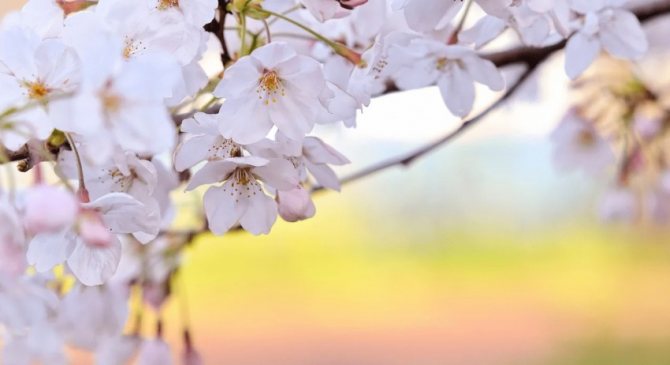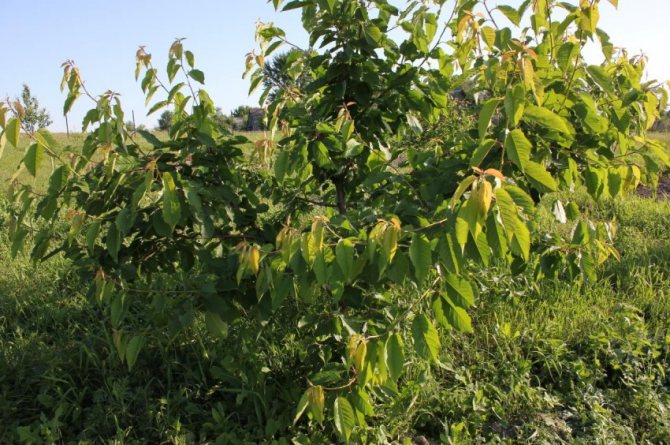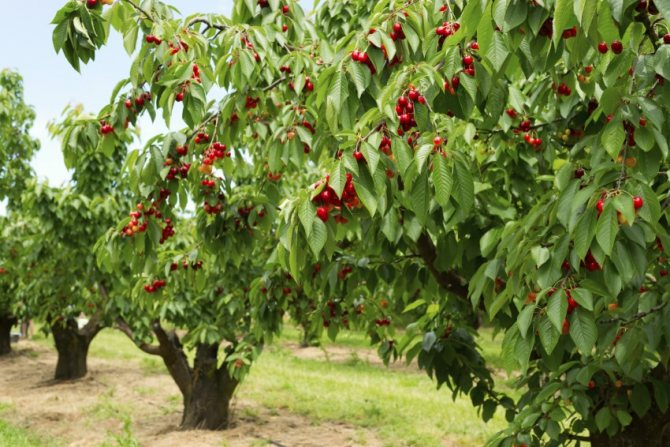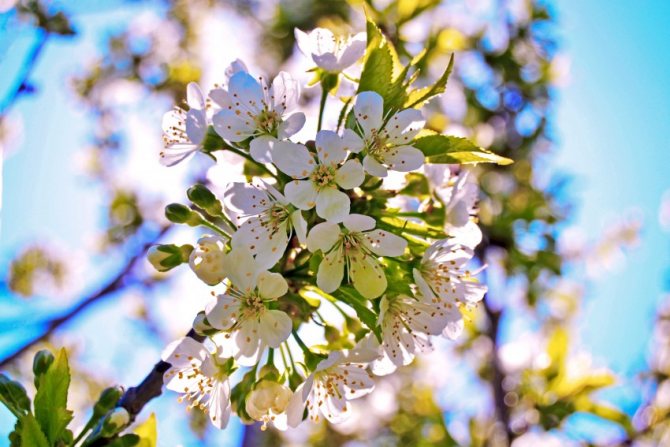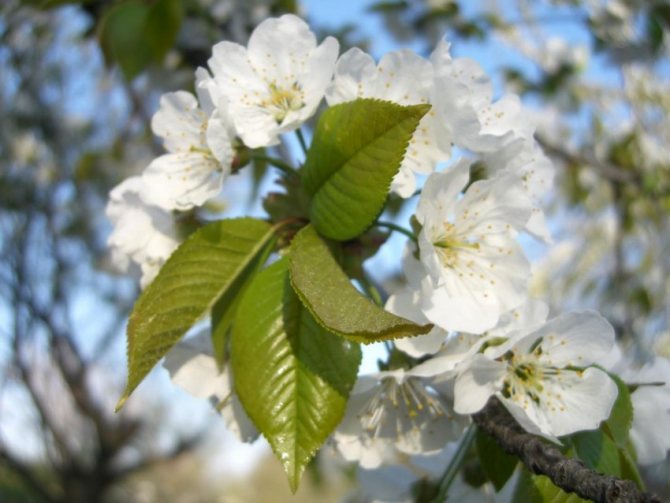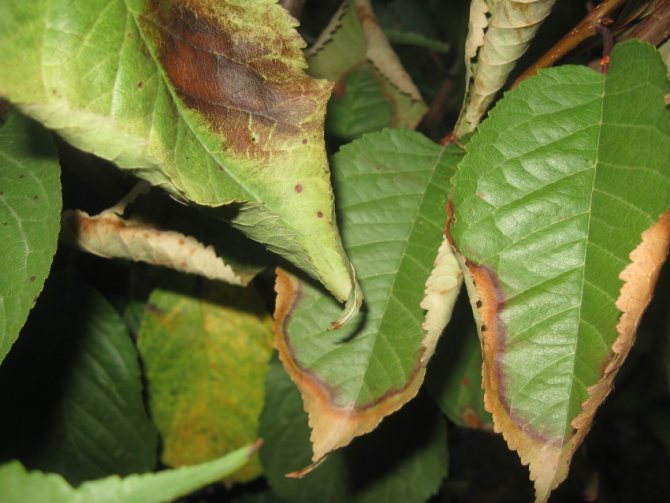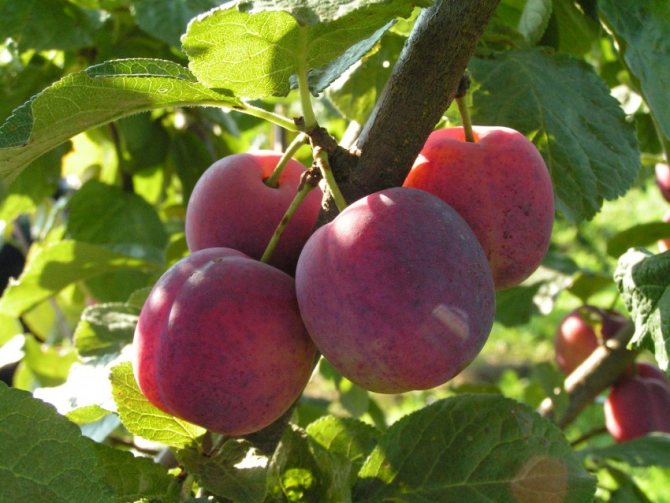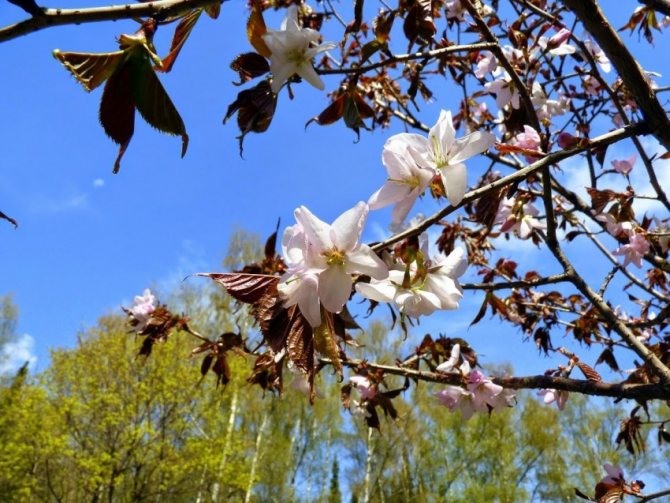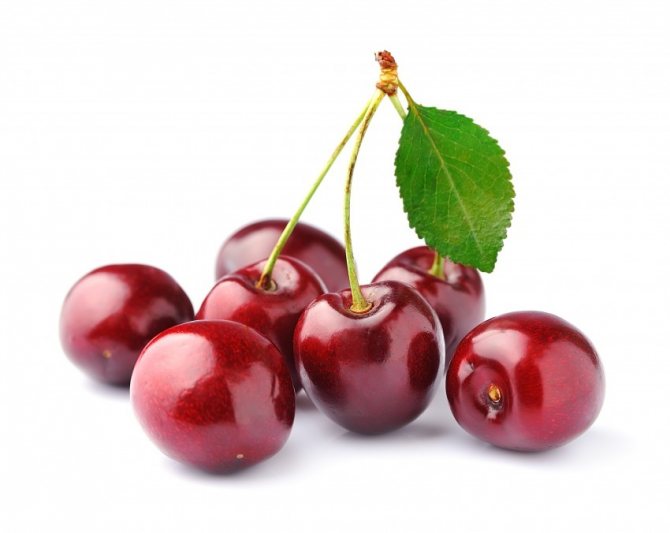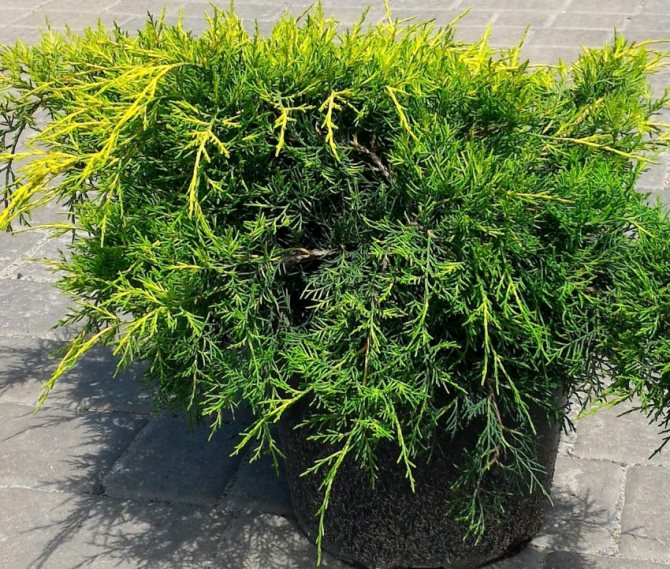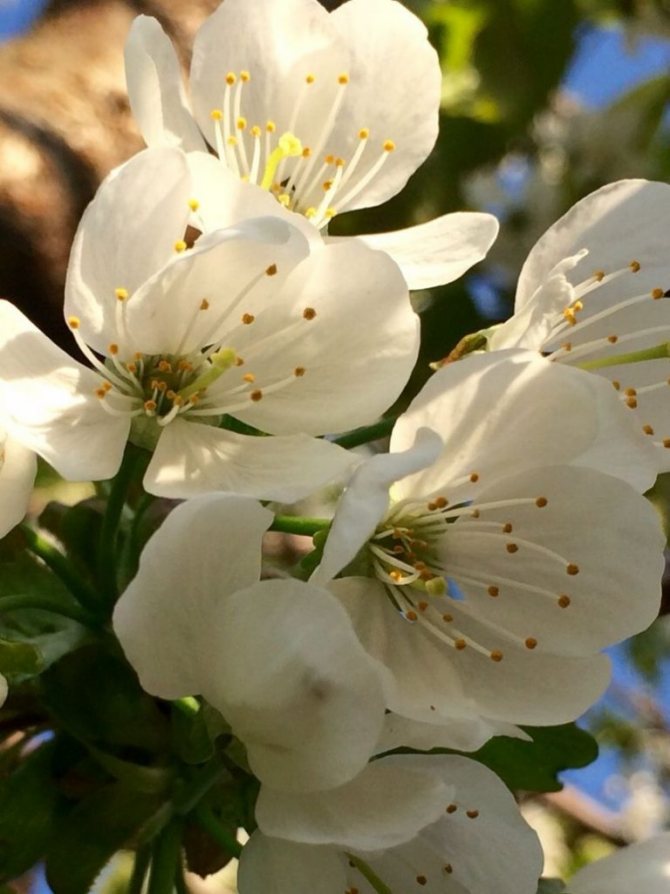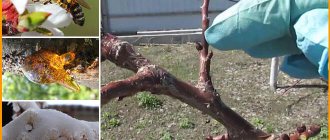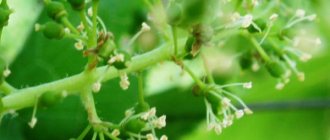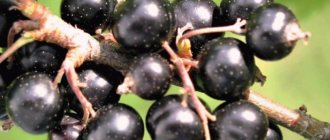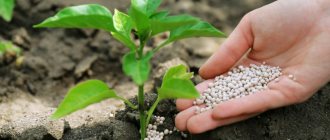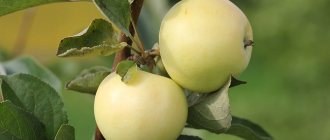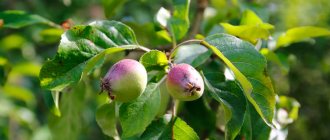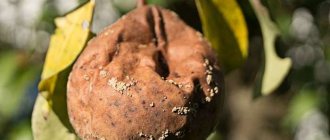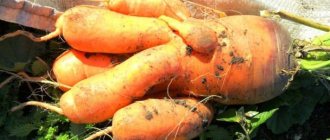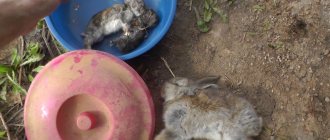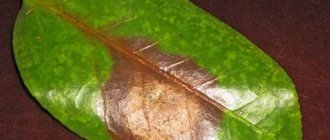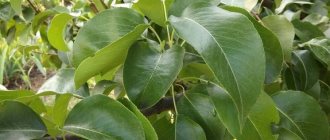Cherry does not bear fruit. What could be the reason? - expert answers
Other entries about cherries
Did you know that Chekhov's famous play is known abroad as "The Cherry Orchard"? And all because the words: "cherry" and "cherry" have an identical translation in many European languages. For example, in English they are translated as - cherry, into ...
I bought two cherries in the nursery. Dali Valery Skolov and Bryansk pink. It turned out one early, the other late. Can they pollinate each other? Or urgently to do something?
A question from our subscriber Irina: I can't understand why my cherries stopped growing, I plant a tree in the spring, it takes root perfectly, it winters well, spring begins - the buds bloom, the leaves are large in the palm. by the middle of summer ...
Hello. Last year, two cherry seedlings of the same variety were planted. Later I found out what is necessary for pollination of different varieties. There is not much space for another sweet cherry, and there is no possibility that I will buy another variety (the name of the variety is not ...
I want to Raspopov Gennady Fedrovich. In the spring, when all the trees bloomed, one cherry seemed to stand still and could not wake up, leaves appeared on the upper branches only at the ends, the flower buds did not open, later the buds began ...
We planted cherries last year in the spring. Everything grew well, foliage, but did not bloom. Abundant good foliage. This year, very few leaves have appeared. What could it be?
See all materials about cherries: See all
Why cherries do not bear fruit
Sweet cherry gives a good harvest, if proper care is carried out. Fedor asks us: "Why does the sweet cherry not bear fruit?"
This phenomenon can be explained by several factors, including the peculiarities of pollination of this stone fruit crop and the conditions for its cultivation.
Pollination rules
- Novice gardeners should know that they will receive the first harvest from cherries five to seven years after planting. The tree bears fruit in full force after 10-12 years.
- Most varieties of this fruit crop are self-infertile, that is, they need close proximity of pollinating plants. To achieve maximum pollination, plant at least three varieties of sweet cherries in the garden, the flowering of which will coincide in terms of time.
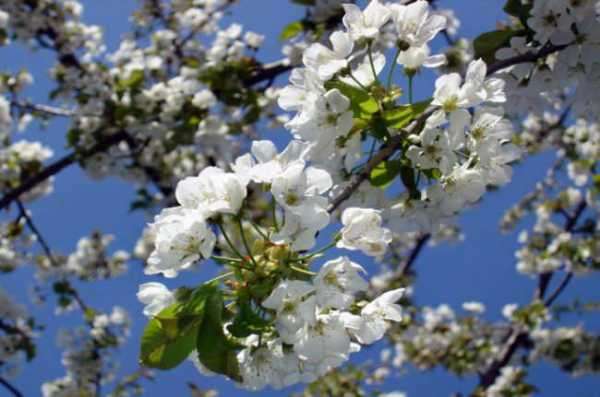
To achieve maximum pollination, plant at least three varieties of sweet cherries in the garden, the flowering of which will coincide in terms of time.
- You can intersperse cherries with cherries on the plot, having learned the axiom: cherries always pollinate cherries, cherries never pollinate. True, cross-pollination in cherry trees is much more successful than in cherry trees. Therefore, cherries bear fruit more intensively.
- "Narodnaya Syubarova" is the name of a self-fertile sweet cherry variety. Experienced summer residents are well aware of the partially self-fertile varieties - "Ovstuzhenka" and "Iput". But self-fertile and partially self-fertile crops only benefit from cross-pollination, bearing more fruits of excellent taste.
By the way, it is Iput and the Chermashnaya variety that are considered universal pollinators for all cherries in central Russia.
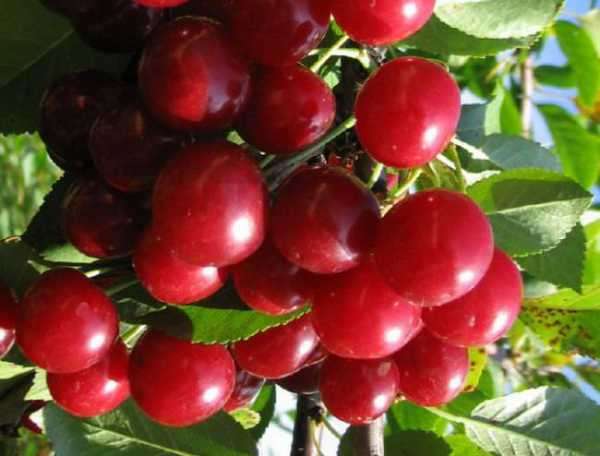

"Narodnaya Syubarova" is the name of a self-fertile cherry variety
Why does not it bear fruit
Bad weather during flowering trees also does not contribute to high yields.Pollinating insects are afraid of dampness and coolness, and pollen loses its "fertile" properties in intense heat.
A cherry tree does not bear fruit if you have not fertilized the ground in time. The correct feeding looks like this:
- in the fall, 70 g of potash and 200 g of phosphorus fertilizers are applied;
- in the spring - urea (70 g);
- as soon as the cherry blossoms, it is poured with water (10 l) with superphosphate (25 g), potassium chloride (15 g) and urea (15 g);
- two weeks later, the tree is "fed" with this solution again.
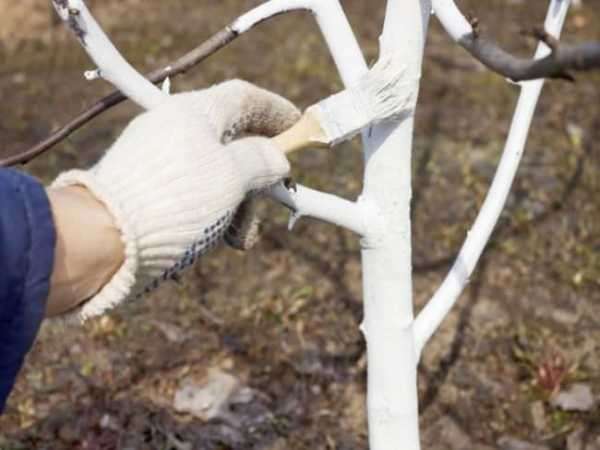

It is also possible to increase the yield of cherry plantings by "healing" wounds, whitewashing the trunks and methodically destroying garden pests
Sweet cherries grow well on fertile lands of neutral acidity, but they do not like waterlogged soil and lack of air for the roots.
An overly dense crown is another enemy of yield: cherries need sunlight. It is necessary to get rid of the affected, dried branches and those that grow inside the crown.
It is also possible to increase the yield of cherry plantings by "healing" wounds, whitewashing the trunks and methodically destroying garden pests.
It must be remembered that sweet cherry is not a particularly winter-hardy culture and often does not bear fruit due to freezing of the buds.
After reading the corresponding article on our resource, you can find out how pruning of apricots and cherries is carried out.
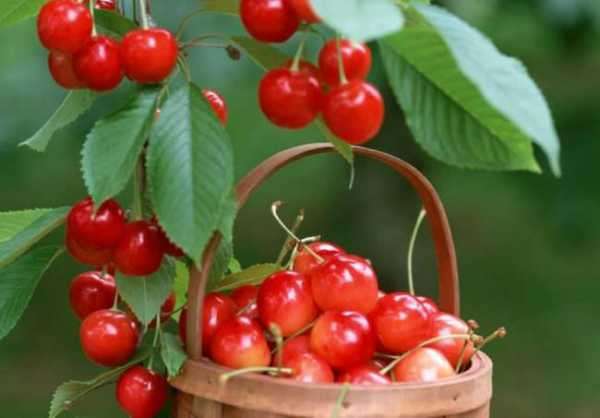

"Slava Zhukova" - a frost-resistant sweet cherry variety
Agronomists recommend
In recent years, breeders have developed several cherry varieties that produce delicious berries and are highly resistant to frost.
- The sweetest, medium-late ripening - "Veda", "Revna", "Sinyavskaya", "Rossoshanskaya gold".
- Slightly sour, but also very juicy - "Pink Pearl", "Leningradskaya Black", "Bryanskaya Pink", "Compact Venyaminova", "Venus", "Fatezh", "Diana".
- The most frost-resistant and no less tasty are Slava Zhukova and Julia.
Feeding cherries (video)
And a little advice for those who did not manage to plant cross-pollinators for their cherries on the site. Try to find a flowering pollinator branch and place it in a bucket of water near a flowering cherry tree. Perhaps soon you will be pleased with the first cherry berries.
Cherry does not bear fruit, reasons, solution to the problem, video
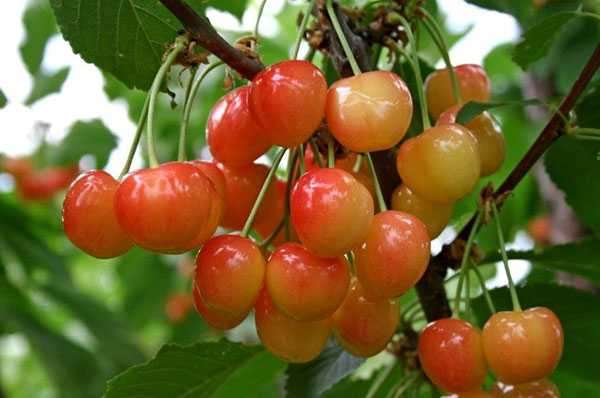

Sweet cherry is a tree that can bear fruit for a hundred years. But in order for the sweet cherry to give large yields, it is necessary to properly care for it.
Choosing a cherry variety
When laying a garden, it is important to choose zoned cherry varieties. In colder climates, early ripening varieties will take root better. Cherry flower buds are more sensitive to cold than deciduous ones. With spring frosts, the branches of the tree may not be affected, but the flower buds will freeze. Therefore, it is better to choose varieties with increased cold resistance.
Correct fit
Often cherries do not bear fruit due to improper planting. The root collar of a fruit tree must not be buried in the ground. It must be kept at ground level, and the graft must be raised 10 cm above ground level. If the root collar is too deep in the soil, then the development of the tree is delayed. The cherry will later enter the fruiting period and the berries will be smaller.
The place for planting cherries should be on the south or southwest side of the site. Most of the daylight hours direct sunlight should fall on cherries.
Cherry fruiting period
Sweet cherry begins to bear fruit 4 years after planting. The tree bears fruit every year. In full force, the cherry begins to bear fruit only after reaching 10 to 12 years, depending on the variety. Yellow cherries begin to bear fruit earlier than red or pink varieties. The tree will begin to bear fruit earlier if the seedling was grown in a container. You can accelerate the entry of cherries into fruiting if you provide good nutrition to the tree and apply mineral fertilizers to the soil every season.
Fertilization and watering
Sweet cherry does not like stagnant water.This is a drought-resistant crop, so watering it is enough only three times per season. 10 liters of water are poured under a 4-year-old cherry in one watering. The first time is watered during the blooming of flower buds, the second - after flowering, the third - after harvesting.
In early spring, when the snow is melting, to increase the ovary, the tree is fed with nitroammophos. Cherry is especially hard to tolerate a lack of potassium, therefore, in early May, before flowering, potash and magnesium-containing fertilizers are applied to the soil. After flowering - again potash fertilizers, but together with herbal infusion or a solution of organic fertilizers.
In summer, beans, mustard or phacelia can be planted in the trunk circle. Then mow it and embed it in the soil.
It is better not to apply nitrogen fertilizers in the autumn period, since the sweet cherry will begin to grow intensively, its shoots will not have time to ripen and will freeze in winter.
Prophylaxis
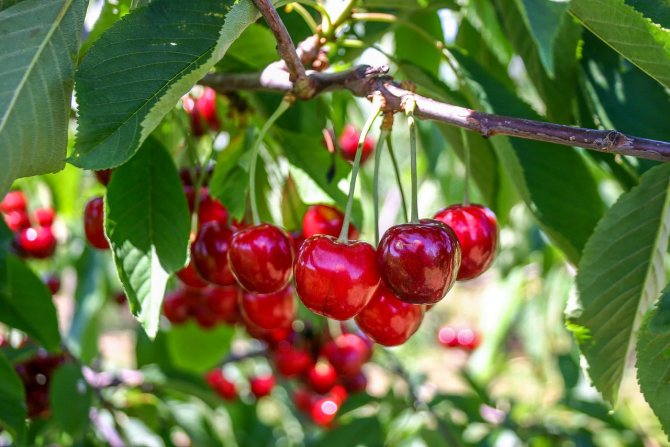

In order to prevent insect parasites and mycotoxicosis, cherries are treated with insectoacaricidal solutions. It is better to choose multidisciplinary products that combine poisons from several types of pests at once. To destroy adults and pupae of insects that hibernate in the soil, you can shed the area under the tree in winter, stepping back 10 cm from the trunk, 20-30 liters of boiling water. The hot water will not have time to burn the roots deep in the ground, but it will scald the insects lying on the surface.
To prevent fungi from infecting the trunk and root system, you need to monitor the moisture in the soil adjacent to the tree. Too wet soil can be sprinkled with sand or a special coagulant can be added - an adsorbent that will absorb excess water. In winter or early spring, tree trunks are whitened with a steep solution of quicklime to a height of 0.5-0.7 meters from the ground. The darker the place where the sweet cherry grows, the higher the limestone column.
Why cherries and cherries do not bear fruit: the main causes of infertility
Often, the spring cherry blossoms are so abundant that the branches of the tree itself are not visible behind the white flowers. Observing such a beautiful and rich flowering, summer residents rejoice, anticipating a high harvest of berries. However, abundant flowering does not guarantee a rich harvest.
It so happens that at the right time, when berries should already appear on the tree, this is not observed. Gardeners are anxiously awaiting the appearance of such a long-awaited harvest, but all in vain. The only question is ripening: why does the cherry not bear fruit, after such an abundant flowering?
Reasons for low yields of cherries and cherries
Currently, this problem worries many gardeners and summer residents - the harvest has clearly decreased. After years of hard struggle with the naughty cherry, many give up and give up unsuccessful attempts to grow it. Everyone can give up, but only a few will deal with the reasons that prevent the plant from producing a rich harvest of berries.
So let's try to find out what is the reason for the low yield. Several factors lead to infertility and low yield of cherries.
Plant variety
It is one of the main causes of tree sterility. Not everyone knows that most cherry tree varieties are self-fertile. This means that the cherry needs a neighborhood with a tree of a different variety, otherwise it will be able to tie only five percent of the ovaries. The fact is that cherry is a cross-pollinated plant and ovaries appear only when pollen from other varieties gets on the pistils of flowers. Cherry varieties are subdivided into:
- Self-infertile - only 5% of the ovaries tie on their own;
- Partially self-fertile - they tie 20% of the ovaries on their own;
- Self-fertile - they tie more than 50% of the ovaries on their own.
And therefore, in order for self-fertile and partially self-fertile cherries to fully bear fruit, it is necessary to plant cherries of the recommended pollination varieties next to them.It is important that the timing of flowering for trees planted in the neighborhood coincides.
Cherry is a tree that does not like loneliness. Even self-fertile varieties will benefit from being adjacent to a different tree. Some, in order to get a bountiful harvest of berries, create entire cherry orchards. That is why, if you want to grow and get a rich harvest of fruits, you should not be limited to one variety.
Weather
Frosts in the spring cause tremendous damage to the tree in terms of fruiting. Frosts are especially dangerous if the temperature in the daytime already rises above 10 degrees. Night frosts lead to the death of flowers and ovaries. Temperatures of minus 1-2 degrees are already dangerous for cherry blossoms. But if we can easily solve the question of pollination of flowers, in this case it is not easy to help the tree.
Return frosts in spring occur annually and last up to several weeks. You can help the tree in this situation by delaying the beginning of flowering as much as possible, by keeping the snow cover under the tree for as long as possible.
Another reason for the low or lack of cherry and sweet cherry harvest is the winter cold. The buds of a tree can freeze during winter frosts, as well as if the tree is not prepared for the cold, for example, in the frosts that occur in late autumn. The risk of freezing can be increased due to abundant watering or nitrogen fertilization of the tree in late summer.
Lack of nutrients and poor growing terrain
Cherry is a rather demanding tree for the soil on which it grows. Cherries will delight you with a rich harvest with the acidity of the soil optimal for it - as close as possible to neutral. In this case, the depth of soil water should not be less than one and a half meters. In the case of peat bogs, the soil should be limed, and in the case of sand, clay and organic matter will do.
However, limed soil may need boron - without it, cherries cannot form ovaries. To avoid this, in the autumn period, it is necessary to dig up the trunk circles and loosen the ground under the bushes with the addition of rotted manure and dry wood ash to the soil - half a glass per 1 sq. m.
The plant can be weakened or depressed. The appearance of the tree will tell you about this:
- low annual growth rates;
- bare tree branches without branches;
- gum often oozes from the tree trunk;
- other signs indicating the weakening of the plant.
At the same time, the cherry can bloom, but it will not bear fruit due to lack of strength. This is due to poor soil, nearby groundwater, or overly buried planting. Cherries will not yield a rich harvest if the soil is too acidic, in a shady or swampy area.
When planting, it is necessary to follow the root collar of the seedling - it should be at the level of the soil. Do not immerse it deeply in the soil - this will greatly weaken the tree. The same effect can be obtained due to excessive thickening, the presence of wounds and cuts on the tree trunk.
Prune and thin the crown regularly. In this case, it is necessary to get rid of dry, damaged, intertwining and inwardly directed branches. As you know, cherries are divided into:
- tree-like;
- bushy.
Each cherry shape has its own characteristics of thinning and pruning the crown. Trimming the cherry tree shape consists of trimming one third of the length. Bush pruning is the removal of the branches of the shrub to the first normal branching.
Using unsuitable seedlings when planting
Another reason for infertility can be the seedlings used for planting.
Newbie mistakes
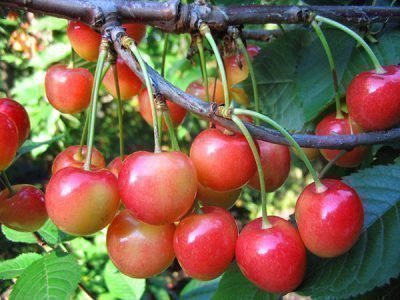

Most beginner mistakes start with the word "wrong."
This is the wrong choice of a seedling that will not be able to grow and bear fruit normally in this region. This is followed by the wrong choice of planting site and the wrong choice of neighboring crops.
Cherry does not like transplants very much, therefore, the place for planting a seedling should be chosen finally and on the basis of information on how to properly transplant a cherry. Proper soil preparation is very important.
Often, beginners, believing that the more fertilizers, the better, add such amounts of drugs to the soil that lead to the death of the plant. For the winter, young cherry trees need to be covered very carefully, protecting them not only from frost, but also from rodents. Otherwise, then you will have to reanimate the cherry after winter.
Why cherry blossoms but does not bear fruit? What to do in this case?
The peculiarity of this tree is the excessive amount of growth that grows every year from the root system of a healthy cherry. Some trees reproduce this way.
However, shoots borrowed from neighbors do not provide a similar variety. This is due to the fact that in grafted trees from the roots, shoots grow not of varietal plants, but of wild ones. For propagation of a variety grafted in the wild, it is necessary to plant not overgrowths, but cuttings from the crown.
In addition to the above reasons for infertility and infertility of cherries, there are others: pests, all kinds of lesions and diseases. But they happen much less often.
Don't forget about standard preventative maintenance measures for the fruit tree. Regularly weed the area around the trunk, removing weeds, treating and treating wounds, whitewashing the trunk, spraying the tree from pests.
For your garden, it is better to select a zoned variety. Such varieties are bred taking into account the climatic characteristics of the region.
Cherry blossoms, but does not bear fruit - what to do?
In our region, an ordinary cherry is considered a fairly common tree, the fruits of which we so love to eat fresh, use as a filling for dumplings and cakes, and preserve for the winter. In addition to sweet and sour berries, cherries are valued for their relative unpretentiousness. Despite this, sometimes gardeners complain that the cherry blossoms profusely, but, unfortunately, does not bear fruit. Of course, such a fact cannot but frustrate, but we will try to figure out why this is happening and what to do if the cherry does not bear fruit well.
Why doesn't the cherry bear fruit?
To understand how to make a tree yield a crop, you need to figure out why this does not happen. In general, if we talk about what year the cherry bears fruit after planting, then most often the first berries should appear on the branches for 3-4 years.
If this does not happen from year to year, provided that there is still flowering in the spring, you need to take action. So, the reasons why the cherry does not bear fruit may be:
- insufficient pollination due to the lack of nearby cherries of other varieties or pollinating insects;
- freezing of buds or already opened flowers;
- insufficient care (watering, top dressing, unsuitable soil), due to which the tree is depressed and unable to produce crops.
Cherry blossoms, but does not bear fruit - what to do?
Several solutions are proposed to solve such an urgent problem. Most often, the cherry does not bloom due to the fact that the fruit buds can freeze in the fall. Therefore, at this time of the year, it is recommended not to fertilize with nitrogen fertilizers and not to irrigate at a time when the first autumn frosts come. In spring, during frosts, you can delay flowering by covering the near-stem circle of cherries with snow or mulch. If flowering has already begun, you can save the potential crop by covering the entire crown with a cloth or non-woven material.
When thinking about how to make cherries bear fruit, be sure to pay attention to the sufficient pollination of your tree. Unfortunately, not all varieties are self-pollinating. Therefore, in the absence of a crop for 4-5 years, it is recommended to plant a sapling of another variety near the cherry.It also happens that the pollination of buds does not occur due to the fact that pollen is not carried by pollinating insects (wasps, bees, bumblebees, etc.). This happens due to unfavorable weather or the use of insecticides against cherry pests. Spraying a product such as Ovary, Blossom, or Bud can help the buds develop a pollinator-free ovary. Well, you can attract insects to the tree with the help of sweet syrup. It is made from a liter of water and a tablespoon of sugar. This sweetened water should be sprayed over the crown of the cherry.
Sometimes, in order to make cherries bear fruit, it is enough to adhere to the rules of proper care for this garden crop. From the very beginning, it is important to plant the seedling correctly. For example, a tree should be planted in sunny areas with loose soil with a neutral or slightly acidic reaction. If necessary, the land will have to be limed. It is also important that the subsoil water is located at least one and a half meters underground. When planting, the root collar of a cherry does not need to be excessively deepened - it is placed at the level of the soil surface. In the future, the tree will need at least three waterings (in late spring, in June, in July). As for feeding, it is produced only in the third or fourth year of seedling growth, using organic or mineral fertilizers.
Care for better fruiting
If the cherry does not bear fruit for a long time, it needs more attention from the gardener. If you follow all the rules for planting and care, you can grow a tree that will delight you every year with delicious and juicy fruits. It is worth paying attention to the recommendations for care.
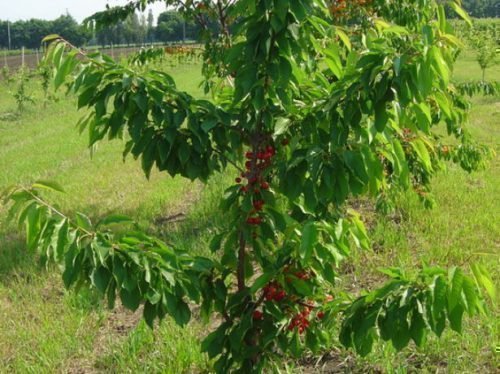

Watering is carried out at intervals of 14 days. Excessive moisture leads to the fact that the roots of the plant begin to rot. As a result, the tree ceases to function normally (the number of ovaries and shoots decreases), which affects the timing of fruiting.
A few days before watering, it is recommended to apply fertilizer to the ground. Combined feeding should be preferred. For the first time, you can feed the culture with organic substances. For this, humus is used (at the rate of 2 kg per 1 m2). The second time feeding is carried out using a solution of superphosphate (50 g per 10 l of water) or ammonium nitrate (30 g per 10 l of water).
For maximum yield, the crown is often watered with a solution of honey. Bees flock to the sweet aftertaste and pollinate the plant.
In order to avoid the invasion of parasites and diseases, it is advisable to spray the culture with a solution of urea (30 g per 10 l of water) or copper sulfate (10 g per 10 l of water).
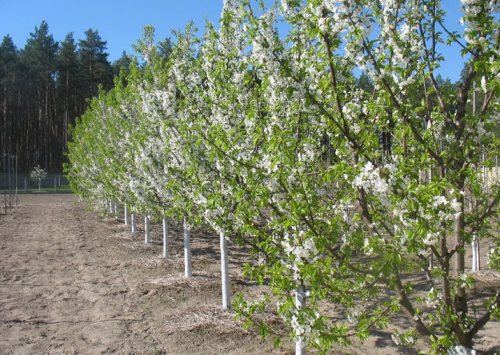

When leaving, it is recommended to pay attention to the place where the cherry is grown, its appearance and climatic conditions. In hot regions of the country, watering is carried out much more often, as the soil dries up, and top dressing should be lighter. At such moments, all the same solutions are used, only their concentration should be 2 times less.
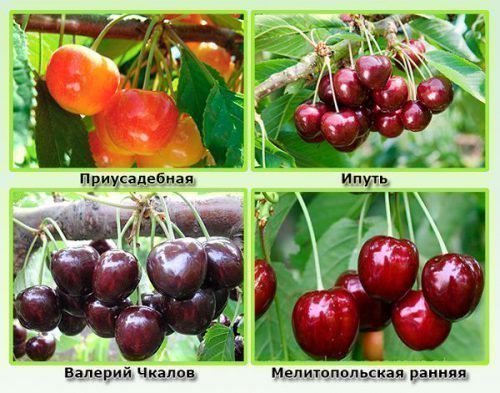

Why does the sweet cherry not bear fruit?
Sometimes the lack of a crop is explained by the excessive volume and thickening of the crown, which is why the cherry does not have "strength" for fruiting. Therefore, it is recommended to prune the tree in the spring.
There are a lot of reasons why cherries do not bloom
Cherry trees are not only a decoration of the garden, but also a source of incomparably tasty and healthy delicacies. Sweet cherries can live and bear fruit for up to 100 years. It is less affected by pests than cherry, has a high yield with proper care.
If you violate the cultivation technology, you will not be able to enjoy the fruits of the plant. Often, novice gardeners ask themselves why the sweet cherry does not bloom? The answer may lie in the peculiarities of tree care: violations of the rules of planting, pruning, watering. Flowering is also affected by the presence of a pollinator near the tree. For similar reasons, gardening enthusiasts note that the plum does not bloom.What to do in such a situation and how to organize proper care of the plant? Read more about the problem and its solutions below.
Note to gardeners
By the time of flowering, the fruit tree is one of those that do not begin to smell too early, but not too late. Facts:
Usually this period coincides with the flowering of pears, plums. It is a little earlier than that of cherries, apples, but proceeds later than peaches and apricots.
Flowering begins when the air temperature during the day is firmly kept at the level of 15-25 degrees (average daily temperatures - at least 10-12 degrees).
The calendar flowering period depends on the area where the cherry tree grows and the weather conditions in the current winter. Usually, the first flowers bloom from the first decade of April (in the south of the country) to the first days of May (in the northeastern territories). The earliest buds bloom on cherry-hybrid varieties.
The flowers of the fruit tree are collected in large umbellate inflorescences.
The beautiful and vibrant bloom lasts about 21 days, which also depends on the temperature values. If the spring is cool, the period can take up to 23-25 days.
Possible reasons for missing colors
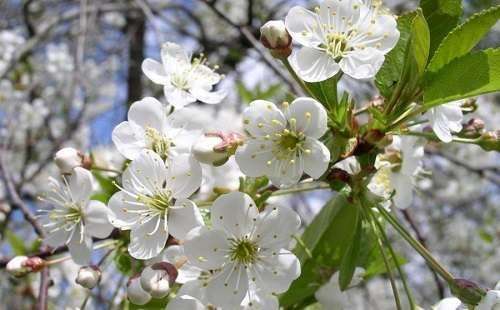

The time has not come
The reason why the tree does not bloom may be insufficient time elapsed since planting. Although cherries are rather early-growing (up to 3 years old), some varieties do not give color and fruit for an even longer period (up to 5 years). Therefore, if you want to quickly enjoy the delicious berries, it is better to buy varieties that are prone to early fruiting.
Wrong choice of place and method of landing
The choice of a place for a tree will be optimal if it:
- located on the south, southwest side of the garden;
- the site is well protected from cold drafts (it is best if this site is a gentle slope of a small hill);
- for artificial elevation of the place for the tree, an additional layer of soil up to 40 cm high is poured;
- illumination for cherries should also be sufficient (especially in spring, shading of the tree should not be allowed).
If these conditions are not met, the plant may not bloom for many years.
Flowering problems are not uncommon even when the type of soil is unsuitable for the tree. The ideal option is a fertile and well-saturated soil, loose, medium loamy or sandy loam. If you plant a plant in an area with heavy clay or peaty soil, the top layer of earth with an excess of sand, cherries are unlikely to bloom and bear fruit. The close occurrence of groundwater can lead to stagnation of moisture in the area of cherry roots and their decay, therefore, the plant will wither and not bloom.
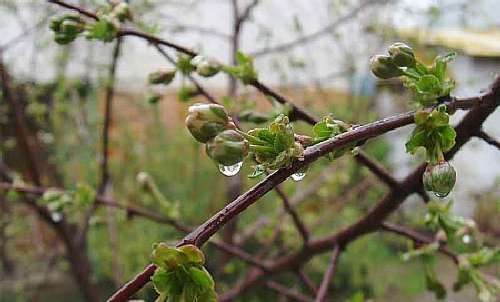

What could be the wrong landing method?
A common reason why apricot, cherry or sweet cherry does not bloom is the wrong planting of the seedling. Usually, if you dig out such a tree, it will be noticeable that the root collar is very deep. Some inexperienced gardeners, on the contrary, leave the neck too high above the ground. In this case, there may be problems with flowering and fruiting of the plant. When planting in early spring (before the buds swell), you must follow the sequence of actions.
1. Purchase high-quality seedlings, prepare a recess for planting. The planting pit should be up to 50-60 cm deep and up to 80 cm wide. Add humus, fertilizers or ash to the pit.
2. In order for the plant to bloom and bear fruit in the future, it is unacceptable to deepen the root collar. It is located strictly at the soil level. In order to accurately position the tree, it is better to raise the seedling 5 cm above the surface, as the soil will settle a little later.
3. Form a roller around the seedling, pour over the cherries with water (10-15 liters), mulch the soil with peat or humus.
Excess or lack of moisture
Watering problems or excessive soil moisture is another cause of the problem.During the summer, you need to water the plant 3 times (if the season is too dry), each time loosening the soil a little. Before the fall in temperature (at the end of September), it is also better to water the cherries. If the last watering of the year has not been possible, it should be done in the spring. But we must remember that excess moisture in the soil also harms cherries, and it may not give color. In heavy rains, it is better to mulch the soil with a special film.
Addiction to feeding
In order for the cherry to bloom early, it is necessary that it has a sufficient supply of minerals in the ground. Usually, fertilizing is carried out in the fall.
For this purpose, the soil is fertilized with nitrogen and phosphorus substances, organic matter. Ideally, the amount of top dressing is calculated based on the type of soil. The depth of application is 20 cm. In arid climates, fertilizers are diluted with water, in wet climates, they are covered with dry ones.
Good effect on the ability to flowering and fruiting and the presence of "green fertilizers". For this purpose, legumes, honey plants (for example, mustard, peas, etc.) can be planted around. They are sown in summer and mowed in autumn.
Few people know that cherries can also "fatten" due to excess fertilizers, especially nitrogen. In this case, experienced gardeners recommend slightly damaging the bark on the tree trunk. You can remove the bark anywhere around the circumference of the trunk with a width of 2-5 cm. As a result of such actions, the accumulated surplus of nutrients will quickly be spent on restoring the integrity of the tree.
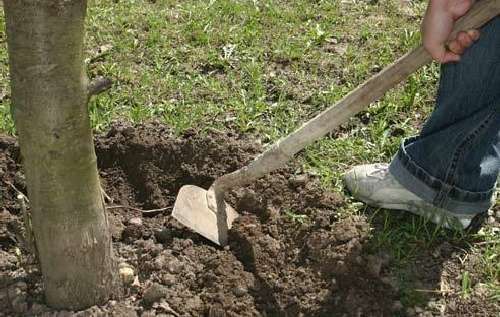

Unsuccessful pruning
In order for the plant to bloom well, it is necessary to form a tiered or cupped crown with the help of pruning. Attention is also paid to the branching angle: it should be approximately 50 degrees. Excessive growth of the lower shoots of the tree is undesirable, since this phenomenon greatly reduces winter hardiness.
Pruning is done in early spring. All annual shoots are made one-fifth shorter, but only before the beginning of fruiting. After pruning is carried out rarely and in urgent need: branches that go inside the crown, sharp forks, weak branches, etc. are necessarily removed. When pruning diseased shoots, the sections must be cleaned well and treated with special means.
Pests and diseases
Various diseases and insect pests can cause significant damage to the plant. Sweet cherries are less susceptible to disease than the same cherries, but they can still be affected by:
coccomycosis - browning of leaves and their early abscission, as a result of which winter hardiness decreases;
moniliosis - rotting and drying of fruits and leaves, defeat of whole branches, due to which the next year the sick cherry may not bloom;
larvae of various insects. destroying leaves and capable of causing a general weakening of the cherry and its freezing in winter.
To prevent serious consequences when diseases are detected, the tree is treated with special preparations and extraordinary feeding is carried out.
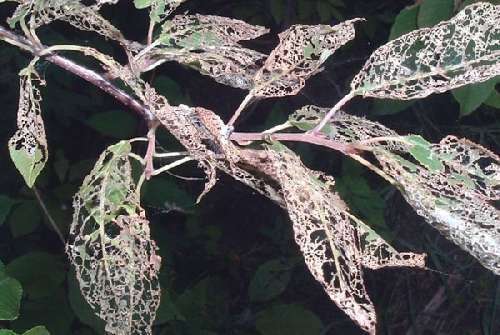

How did the tree endure the winter?
Sweet cherries may not bloom if the frost resistance of the variety is low, and the winter was severe and cold. In this case, the kidneys could die due to hypothermia. Cherry rarely blooms in a year, when there were long thaws in winter, after which frost "hit" again: most often the buds also die in such weather. The plant may freeze up in spring at low average daily temperatures. For the winter, it is better to bury the cherries with soil, forming a high roller, and also water them with water (at least 40 liters). You can cover the tree if winter temperatures are low or unstable.
No pollination
There is another commonplace reason why cherries may not give color. More often, the tree still blooms, but does not bear fruit. The fact is that there are so-called "self-fertile varieties" that are pollinated without "outside" help. Other varieties of cherries require the presence of trees on the site - cherries, other varieties of cherries for pollination. The flowering periods of the plants must match.
Thus, you can always identify the reason why the cherry did not bloom, even if at first glance it is not found. Having eliminated it, it is possible in the next year or two to see an exuberant color and get an excellent yield of sweet cherries!
| Gardening for July »Gardening for June» Gardening for May » | About the cottage, garden, vegetable garden, flowers and the estate on our forum. | How well do you know home farming? |
Correct fit
In order for the cherries to begin bearing fruit on time and produce tasty fruits, planting should be carried out according to certain rules.
The tree needs fertile soil and maximum sunlight.
If you neglect these recommendations and determine the seedling in the wrong place, you can not expect a timely harvest.
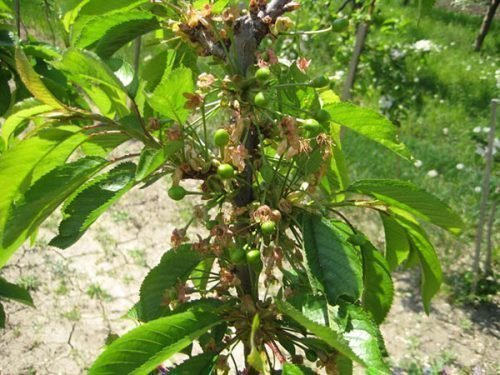

There are a few more basic rules to keep in mind when planting a tree.
- Planting should be done close to other pollinators. For these purposes, you should use different varieties of cherries. So that the cherry can bear fruit as efficiently as possible, it is planted next to the cherry. When these trees stand side by side, maximum pollination occurs, contributing to the acceleration of the fruiting process.
- In cooler regions (northern part of the country), planting should be carried out in early spring. In the southern parts of the country, planting takes place in October.
- The hole for planting a seedling should be of such a size that the root system of the plant is freely located over the entire area. Root constraint should not be allowed.
- Often the plant does not bear fruit well if the soil has an insufficient amount of nutrients or excessive moisture, therefore it is recommended to pour sand on the bottom of the hole so that the moisture is absorbed faster and does not lead to decay of the roots.
Why cherries do not bear fruit: what to do, main reasons, treatment, help
So, what needs to be taken into account and done so that cherries in the garden plot successfully grow and bear fruit?
First of all, you need to choose the right varieties, plant on site only those that have been tested and approved for cultivation in the region. In the Central region, the following varieties are allowed for reproduction and cultivation: Fatezh, Chermashnaya, Iput, Revna, Tyutchevka, Rechitsa, Raditsa, Bryanskaya rozovaya, Teremoshka, etc. east of the capital. To the north of Moscow (in the Dmitrov and Sergiev Posad districts), it is risky to grow cherries: here they can often freeze slightly and bear fruit irregularly. Ignoring this circumstance has more than once led amateur gardeners to disappointment in cherries.
Observations have shown that with a gradual decrease in temperature air cherry crown can withstand winter frosts up to 300. Thaws are more dangerous for it in the winter-spring period, followed by a decrease in temperature to minus 250. This causes freezing of flower buds and leads to a decrease, and sometimes a complete lack of yield.
According to N.G. Morozova (VSTISP, Moscow), of the studied cherry varieties, the Fatezh variety turned out to be the most winter-hardy. The varieties Chermashnaya, Sinyavskaya and others were inferior to him on this basis.
Gardeners should also take into account that the cherry varieties bred for the middle lane - self-fertile, so you need to have at least two trees of different varieties. For cross pollination, they should be of early and medium or medium and late flowering time. For example, the medium-flowering Fatezh variety can be a good pollinator for early flowering varieties - Chermashnaya, Iput, Ovstuzhenka, Sinyavskaya. At the same time, the medium-flowering varieties Fatezh, Rechitsa, Teremoshka are good pollinators for the late varieties Revna, Bryanskaya rozovaya, Tyutchevka, Odrinka. The combination of early and late flowering varieties is not suitable for mutual cross-pollination: these dates may not coincide. For example, according to M.V. Kanshina (All-Russian Research Institute of Lupina, St.Bryansk), variety Bryanskaya rozovaya (early) turned out to be a poor pollinator for varieties with a later flowering period - Revna, Pamyat Astakhova, Lyubimtsa Astakhova, Raditsa.
For reliable cross-pollination, normal growth and fruiting trees cherries should preferably be planted at a distance of 3-4 m from each other. If there is room for only one tree on the site, then two or three varieties need to be grafted on it for mutual pollination.
Often failures in growing cherries are associated with a loved one (less than 1.5 m) by the occurrence of groundwater or waterlogging of the soil due to stagnation of flood or rainwater. Waterlogging has a depressing effect on cherries. With an excess of moisture, the roots suffocate, the annual growth of the shoots (8-10 cm) weaken, the trees are oppressed and gradually fall out. To get rid of excess snow or rain moisture, ditches 60-80 cm deep must be dug around the garden area.
The strength of growth, the regularity of fruiting and the durability of trees largely depend on a properly selected stock.... When buying seedlings, take an interest not only in the variety, but also in the type of rootstock. The use of cherries as a rootstock for cherries is undesirable. If this is neglected, then by the age of 5-7 years a swelling is formed at the site of vaccination, indicating a partial incompatibility of the scion with the stock. Such trees are short-lived. Signs of incompatibility do not appear when using zoned rootstocks. In the middle lane for cherries it is recommended to use vegetatively propagated rootstocks VTs-13, LC-52, Muscovy and cherry seedlings Bryanskaya pink.
In order for cherries to grow well and bear fruit, they need to be carefully looked after.: in the spring, regularly prune, apply fertilizers, water in the heat (especially on light sandy soils). Young cherry trees tend to give strong (80-120 cm) annual growth. Their upper part (30-40 cm) often does not ripen, it freezes in winter, and in spring it has to be removed. It is more rational to do otherwise: in the summer, pinch the tops of the shoots when they reach 60-80 cm. This can cause regrowth of shoots in the second half of summer. Usually the sparse crown will become thicker. If the summer is dry and hot, the summer shoots have time to ripen well, become lignified and overwinter without noticeable frost damage.
Considering that cherry loves slightly acidic soils, and sod-podzolic acidic soils prevail in the Moscow region, it is desirable to carry out liming once every 3-4 years. On light soils, 300-400 g of lime are applied, on heavy soils - 600-800 g per 1 sq. M. In autumn or early spring, lime is evenly scattered under the crown of trees and the soil is dug to a depth of about 20 cm. The introduction of lime promotes better absorption of nutrients by plants from fertilizers embedded in the soil. Lime is also necessary for the formation of seeds during fruit ripening. print version
Back to
Popular varieties and their yield
Breeders are constantly working on the invention of new varieties and types of sweet cherries. Among them there are very early, cold-resistant, with very large fruits, or sweet, but small ones. The buyer chooses to his taste.
The most popular varieties of cherries are discussed below in more detail.
- Revna is a small tree that does not require special care. It bears very tasty fruits, they can be easily transported over long distances, withstand frost and even frost. Average ripening period.
- Vasilisa is an excellent mid-season variety. It has very large berries, their weight sometimes reaches 15 g. Good taste, bright, uniform color, juicy pulp are present. The tree can produce crops for up to 20 years.
- Regina is a late variety. The berries are poured and ripen gradually, delicious, beautiful and appetizing in appearance. Remarkably retains its integrity against fungi and garden pests, is not afraid of cold weather, it is not difficult to care for a fruit tree.
- Yellow - the berries ripen for a long time, but they tolerate cold very well. Delicious sun-colored berries attract many people.The taste practically does not differ from red, but savoring them, you get an aesthetic pleasure.
- Bovine heart - berries are large, burgundy, sweet. It gives an excellent harvest, withstands frost, is easily transported over long distances due to the strong skin of the berries.
- Large-fruited - very large fruits of dark red color. The tree is small, comfortable to plant. Calmly endures the cold. The crop feels calm during transportation.
- Cordia has remarkable taste, large (up to 10 g) berries, late ripening. They can be used to make preparations for the winter. The fruits are well preserved, they can be transported over long distances, they do not rot or burst. No matter how much they are transported, they will remain intact and get to a happy consumer.
In addition to the above, there are other equally popular varieties that deserve the attention of every gardener.
- Tyutchevka is a tree with a wide crown and powerful branches. Late grade. Begins to give first fruits at 3 or 4 years. Berries are medium in size. Excellent taste, aroma and presentation. It is easy to transport, sell this berry due to its excellent persistence and transportability.
- The Italian is a self-fertile tree, which is quite rare among cherries. An early variety, ripens quickly and takes all the laurels of the first ripe berry in the new season. The berries are large. Not afraid of frost, viral and fungal diseases.
- Fatezh is a crop with large berries (weighing up to 6 g each); up to 50 kg of berries can be removed from one tree per season. Petioles have a bright taste, the stone is easily extracted from the berry. The tree begins to bear fruit for the first time after 3-4 years of life. It perfectly tolerates cold, transportation, cherries are resistant to many strains of bacteria and fungi.
- Leningrad black - the tree begins to bear fruit after the 3rd year of growth in a permanent place with proper care of the gardener. Excellent taste and color of berries, they are large and mouth-watering, bright burgundy. The pulp is juicy, sweet, there is a slight bitterness in combination with the amazing aroma of ripe cherries. This type of cherry can be used to make compotes and preserves for rolling, they will not spoil and explode. Black cherry does not require special care and special conditions for growth.
- Bakhor bears fruit every year without interruption. Withstands frosts, diseases. The crop can be easily sold and not be afraid that it will burst or flow. You can roll up compotes and jams. It is easy to remove the bone from the pulp.
Fatezh - tolerates cold well and gives a large harvest

